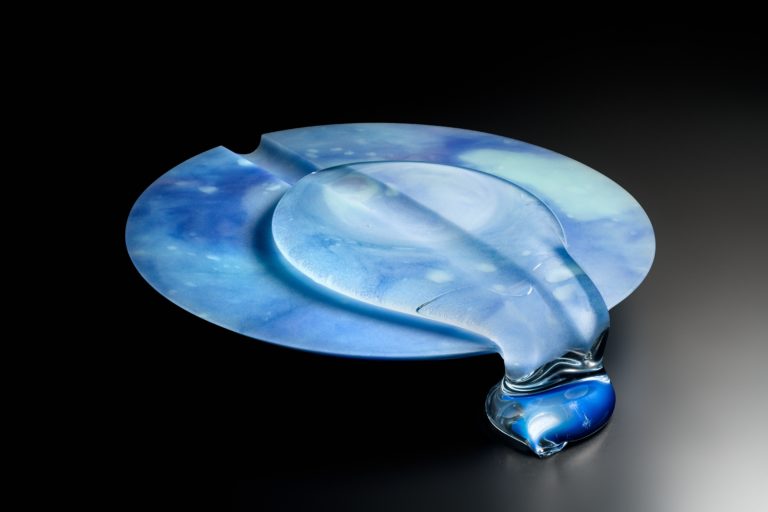As part of the Révélations 2022 art exhibition in Paris, Galerie Kuzebauch will be showcasing a selection of glass artists under the Generation Next banner, as devised by PhDr. Petr Nový, chief curator of the Museum of Glass and Jewellery in Jablonec nad Nisou. Generation Next presents an overview of works by the middle generation of Czech glass artists born during the 1970s-80s. Such artists are characterised by a pioneering and experimental approach that seeks to go beyond the existing boundaries of glass art.

Within the Révélations framework, Galerie Kuzebauch will be showcasing works by four artists that epitomise the concept of Generation Next – meaning an openness to various conceptual and aesthetic forms of experimentation. Artists Zuzana Kubelková, Lucie Švitorková, Ondřej Strnadel and Petr Stanický are all connected, not by a similar aesthetic approach, but rather, conversely, by their variegated natures and insatiable appetite to continue to advance, experiment, and thus to find new paths towards the formation of their respective artistic works. The artists possess highly individualistic approaches towards the glass art craft, as well as highly individual approaches towards seeking fresh avenues of opportunity to break through the commonly encountered limitations of this material.
 Zuzana Kubelková, Icy Blue, 2021, blown glass, basalt textile. Photo: the author’s archive
Zuzana Kubelková, Icy Blue, 2021, blown glass, basalt textile. Photo: the author’s archive
Zuzana Kubelková is a young glass artist chiefly focused on experimenting with glassmaking techniques and materials. Her work has been highly lauded around the world, as evidenced by Kubelková’s receipt of a number of prestigious awards. Among the most recent such honours are this year’s Milano Vetro 35 award. This event, now in its third year, recognises works by the most promising artists and designers aged 35 and under. Zuzana Kubelková found success with her most recent collection of vases, decorated with abstract art and utilising highly customised techniques. A selection from this award-winning collection will be on display at this year’s Révélations exhibition.
Lucie Švitorková is a glass artist chiefly focusing on the technologies associated with fused glass sculptures. This is a particularly demanding glass art discipline, pioneered both at home and abroad, for example, by the famous duo of Stanislav Libeňský and Jaroslava Brychtová. With her distinctive style, Lucie Švitorková ties in to such past traditions, working in the northern Bohemian town of Železný Brod – just as the famous aforementioned duo – thus contributing to the further development of techniques in this glass art field. The artist’s works are characterised by a minimalist approach towards morphology in her vessels, which, however, contain, upon closer inspection, an array of hidden and highly refined examples of decorative ornamentations and optical phenomena.
 Lucie Švitorková, CAVITY II, 2021, moulded fused glass, delustered, polished. Photo: František Nikl
Lucie Švitorková, CAVITY II, 2021, moulded fused glass, delustered, polished. Photo: František Nikl
Petr Stanický works with glass in the spirit of an architect. His art comprises specific, self-contained glass spaces that stimulate a range of senses and emotions in observers. Despite often combining materials in his meticulously designed and constructed works, Stanický only rarely subjugates the inherent natural aesthetic properties of glass. Révélations 2022 will feature two works by this artist – a painting and a sculptural work. These will be linked by a material that morphs into an illusion; a true geometric space in an illusive line; one that serves to both supplement and challenge the displayed works.
Organically shaped works by artist Ondřej Strnadel serve as a kind of counterpoint to the architectural approach found in Stanický’s creations. Strnadel studied Industrial Design at the Tomáš Bata University in Zlín under the noted Professor Pavel Škarka and currently teaches at the High School of Applied Glass Art in Valašské Meziříčí. Entirely abstract hand-blown glass characterises Strnadel’s art, through which the morphology of an expanded geometric aesthetic is generated. The final works are both asymmetric and variously deformed, adding an illusion of both motion and fluidity.
 Ondřej Strnadel, Black Vessel, 2018, hand-blown glass, delustered. Photo: Gabriel Urbánek
Ondřej Strnadel, Black Vessel, 2018, hand-blown glass, delustered. Photo: Gabriel Urbánek







 Euforik, 2022
Euforik, 2022 Dance Face to Face, 2022
Dance Face to Face, 2022
 View of the Outside, 2021
View of the Outside, 2021 View of the Inside I & II, 2019
View of the Inside I & II, 2019 Marie Sixtová – Bond (2019)
Marie Sixtová – Bond (2019) Michaela Trávníčková – Bubbles (2019)
Michaela Trávníčková – Bubbles (2019) Oko, 2003
Oko, 2003 Bob, 2004
Bob, 2004
